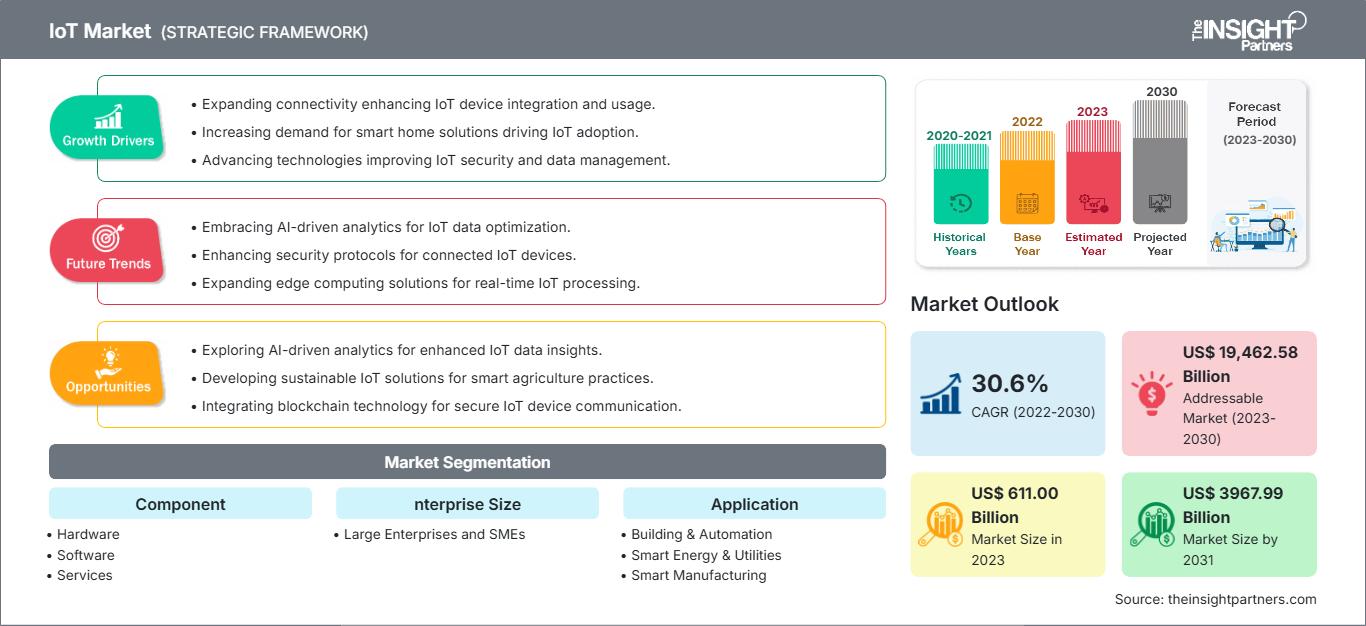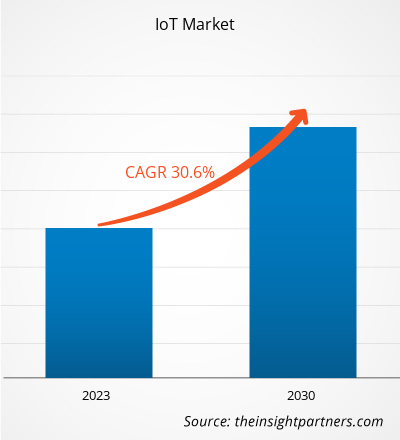Der IoT-Markt soll von 611,0 Milliarden US-Dollar im Jahr 2023 auf 3.967,99 Milliarden US-Dollar im Jahr 2030 anwachsen. Für den Zeitraum 2023–2030 wird eine durchschnittliche jährliche Wachstumsrate (CAGR) von 30,6 % erwartet. Die Verschmelzung von Künstlicher Intelligenz (KI) und IoT dürfte ein wichtiger Markttrend bleiben.
IoT-Marktanalyse
Der IoT-Markt bietet aufgrund der aktuellen Markttrends und ihrer absehbaren Auswirkungen im Prognosezeitraum Wachstumsaussichten. Der IoT-Markt wächst aufgrund von Faktoren wie der zunehmenden Verbreitung von IoT-Geräten, der zunehmenden Widerstandsfähigkeit in der intelligenten Fertigung und der schnellen Digitalisierung in verschiedenen Branchen. Die Entwicklung von Smart Cities und der fortschreitende Ausbau von 5G-Netzen sind einige der Faktoren, die lukrative Wachstumschancen für den IoT-Markt bieten dürften.
IoT-Marktübersicht
Das Internet der Dinge (IoT) ist ein Netzwerk miteinander verbundener Geräte, die miteinander und mit der Cloud Daten austauschen. IoT-Geräte sind typischerweise mit Technologien wie Sensoren und Software ausgestattet. Unternehmen verschiedenster Branchen nutzen IoT, um effizienter zu arbeiten, einen besseren Kundenservice zu bieten, die Entscheidungsfindung zu optimieren und den Unternehmenswert zu steigern.
Passen Sie diesen Bericht Ihren Anforderungen an
Sie erhalten kostenlos Anpassungen an jedem Bericht, einschließlich Teilen dieses Berichts oder einer Analyse auf Länderebene, eines Excel-Datenpakets sowie tolle Angebote und Rabatte für Start-ups und Universitäten.
IoT-Markt: Strategische Einblicke

- Holen Sie sich die wichtigsten Markttrends aus diesem Bericht.Dieses KOSTENLOSE Beispiel umfasst Datenanalysen, die von Markttrends bis hin zu Schätzungen und Prognosen reichen.
Sie erhalten kostenlos Anpassungen an jedem Bericht, einschließlich Teilen dieses Berichts oder einer Analyse auf Länderebene, eines Excel-Datenpakets sowie tolle Angebote und Rabatte für Start-ups und Universitäten.
IoT-Markt: Strategische Einblicke

- Holen Sie sich die wichtigsten Markttrends aus diesem Bericht.Dieses KOSTENLOSE Beispiel umfasst Datenanalysen, die von Markttrends bis hin zu Schätzungen und Prognosen reichen.
IoT-Markttreiber und -Chancen
Zunehmende Nutzung von IoT-Geräten begünstigt den Markt
Das Internet der Dinge (IoT) beschreibt ein weitverbreitetes Netzwerk miteinander verbundener Geräte sowie Technologien, die die Kommunikation zwischen diesen Geräten und der Cloud ermöglichen. In letzter Zeit hat die Nutzung von IoT-Technologien aufgrund von Fortschritten bei mobilen und drahtlosen Konnektivitätstechnologien und einem allmählichen Rückgang der Kosten für Sensoren und andere Komponenten stark zugenommen. Mehrere Branchen nutzen IoT, um die Effizienz zu steigern und die Betriebskosten zu senken. Laut Finance Online gab es im November 2023 rund 14,76 Milliarden vernetzte IoT-Geräte, und diese Zahl soll bis 2030 auf rund 25,44 Milliarden steigen. Einer Prognose von IoT Analytics zufolge werden bis 2030 75 % aller genutzten Geräte IoT-Geräte sein. Darüber hinaus schätzte FinleyUSA die weltweiten IoT-Ausgaben im Jahr 2023 auf 1,1 Billionen US-Dollar. Diese zunehmende Verbreitung von IoT-Geräten treibt das Marktwachstum voran.
Entwicklung von Smart Cities
Die Abhängigkeit von Technologie für ein komfortableres Leben steigt mit dem sich wandelnden Lebensstil von Verbrauchern und Gemeinschaften weltweit. Smart Cities haben in den letzten Jahrzehnten enorm an Bedeutung gewonnen. Laut TWI Ltd. leben 54 % der Weltbevölkerung in Städten, und bis 2050 soll dieser Anteil auf 66 % steigen. Nach Angaben des indischen Ministeriums für Wohnungsbau und Stadtentwicklung (MoHUA) hatten 100 Smart Cities bis Juli 2023 Arbeitsaufträge für 7.978 Projekte erteilt, von denen 5.909 Projekte abgeschlossen wurden. Im Rahmen der SmartAmerica Challenge kündigten Stadtverwaltungen in den USA Pläne an, in den nächsten 20 Jahren rund 41 Billionen US-Dollar zu investieren, um ihre Infrastruktur zu modernisieren und vom Netzwerk vernetzter Geräte zu profitieren. Im Dezember 2023 kündigte ein chinesisches Immobilienentwicklungskonsortium eine Investition von rund 1,85 Billionen US-Dollar in eine neue Smart City in Brasilien an. IoT-Geräte werden zunehmend in Smart Cities eingesetzt und bieten so Wachstumschancen für den Markt.
Segmentierungsanalyse des IoT-Marktberichts
Schlüsselsegmente, die zur Ableitung der IoT-Marktanalyse beigetragen haben, sind Komponente, Unternehmensgröße und Anwendung.
- Basierend auf der Komponente ist der IoT-Markt in Hardware, Software und Dienste unterteilt. Das Hardwaresegment wird im Jahr 2022 einen bedeutenden Marktanteil halten.
- Nach Unternehmensgröße ist der Markt in Großunternehmen und KMU segmentiert. Das Segment der Großunternehmen hatte im Jahr 2022 den größten Marktanteil.
- In Bezug auf die Anwendung ist der Markt in Gebäude & Automatisierung, intelligente Energie & Versorgung, intelligente Fertigung, vernetzte Logistik, Bank- & Finanzdienstleistungen, Luft- und Raumfahrt & Verteidigung und andere segmentiert. Das Segment Smart Manufacturing hatte im Jahr 2022 den größten Marktanteil.
IoT-Marktanteilsanalyse nach Geografie
Der geografische Umfang des IoT-Marktberichts ist hauptsächlich in fünf Regionen unterteilt: Nordamerika, Asien-Pazifik, Europa, Naher Osten und Afrika sowie Süd- und Mittelamerika.
Der IoT-Markt im Asien-Pazifik-Raum erlebt ein schnelles Wachstum, angetrieben von verschiedenen Faktoren wie der enormen Digitalisierung verschiedener Branchen, dem hohen Wachstum des Smart-Manufacturing-Sektors und günstiger staatlicher Unterstützung.
IoTRegionale Einblicke in den IoT-Markt
Die Analysten von The Insight Partners haben die regionalen Trends und Faktoren, die den IoT-Markt im Prognosezeitraum beeinflussen, ausführlich erläutert. In diesem Abschnitt werden auch die IoT-Marktsegmente und die geografische Lage in Nordamerika, Europa, dem asiatisch-pazifischen Raum, dem Nahen Osten und Afrika sowie Süd- und Mittelamerika erörtert.
Umfang des IoT-Marktberichts
| Berichtsattribut | Einzelheiten |
|---|---|
| Marktgröße in 2023 | US$ 611.00 Billion |
| Marktgröße nach 2031 | US$ 3967.99 Billion |
| Globale CAGR (2022 - 2030) | 30.6% |
| Historische Daten | 2020-2021 |
| Prognosezeitraum | 2023-2030 |
| Abgedeckte Segmente |
By Komponente
|
| Abgedeckte Regionen und Länder | Nordamerika
|
| Marktführer und wichtige Unternehmensprofile |
|
Dichte der IoT-Marktakteure: Auswirkungen auf die Geschäftsdynamik verstehen
Der IoT-Markt wächst rasant, angetrieben durch die steigende Endnutzernachfrage aufgrund von Faktoren wie sich verändernden Verbraucherpräferenzen, technologischem Fortschritt und einem stärkeren Bewusstsein für die Produktvorteile. Mit steigender Nachfrage erweitern Unternehmen ihr Angebot, entwickeln Innovationen, um den Bedürfnissen der Verbraucher gerecht zu werden, und nutzen neue Trends, was das Marktwachstum weiter ankurbelt.

- Holen Sie sich die IoT-Markt Übersicht der wichtigsten Akteure
Neuigkeiten und aktuelle Entwicklungen zum IoT-Markt
Der IoT-Markt wird durch die Erhebung qualitativer und quantitativer Daten aus Primär- und Sekundärforschung bewertet, die wichtige Unternehmenspublikationen, Verbandsdaten und Datenbanken umfasst. Einige der Entwicklungen auf dem IoT-Markt sind nachfolgend aufgeführt:
- Vodafone ist eine wichtige strategische Partnerschaft mit Microsoft eingegangen, die die IoT-Kapazitäten von Vodafone erheblich erweitern wird. Diese 10-Jahres-Vereinbarung zielt darauf ab, die Stärken beider Unternehmen zu nutzen, um digitale Plattformen für über 300 Millionen Unternehmen, Organisationen des öffentlichen Sektors und Verbraucher in Europa und Afrika zu transformieren. (Quelle: Vodafone, Pressemitteilung, Januar 2024)
- Soracom, Inc., ein globaler Anbieter fortschrittlicher Konnektivität für das Internet der Dinge (IoT), und die Suzuki Motor Corporation, die Produkte in verschiedenen Mobilitätskategorien anbietet, darunter Autos, Motorräder und Außenbordmotoren, gaben die Unterzeichnung einer Vereinbarung zur weiteren Anwendung fortschrittlicher IoT-Technologien im Bereich Mobilitätsdienste bekannt. (Quelle: Suzuki Motor Corporation, Pressemitteilung, Februar 2024)
Bericht zum IoT-Markt: Umfang und Ergebnisse
Der Bericht „IoT-Marktgröße und -prognose (2020–2030)“ bietet eine detaillierte Marktanalyse in den folgenden Bereichen:
- IoT-Marktgröße und -prognose auf globaler, regionaler und Länderebene für alle abgedeckten wichtigen Marktsegmente
- IoT-Markttrends sowie Marktdynamik wie Treiber, Einschränkungen und wichtige Chancen
- Detaillierte PEST/Porters Five Forces- und SWOT-Analyse
- IoT-Marktanalyse mit wichtigen Markttrends, globalen und regionalen Rahmenbedingungen, wichtigen Akteuren, Vorschriften und aktuellen Marktentwicklungen
- Branchenlandschaft und Wettbewerbsanalyse mit Marktkonzentration, Heatmap-Analyse, prominenten Akteuren und aktuellen Entwicklungen für den IoT-Markt
- Detaillierte Unternehmensprofile
- Historische Analyse (2 Jahre), Basisjahr, Prognose (7 Jahre) mit CAGR
- PEST- und SWOT-Analyse
- Marktgröße Wert/Volumen – Global, Regional, Land
- Branchen- und Wettbewerbslandschaft
- Excel-Datensatz
Aktuelle Berichte
Erfahrungsberichte
Grund zum Kauf
- Fundierte Entscheidungsfindung
- Marktdynamik verstehen
- Wettbewerbsanalyse
- Kundeneinblicke
- Marktprognosen
- Risikominimierung
- Strategische Planung
- Investitionsbegründung
- Identifizierung neuer Märkte
- Verbesserung von Marketingstrategien
- Steigerung der Betriebseffizienz
- Anpassung an regulatorische Trends






















 Kostenlose Probe anfordern für - IoT-Markt
Kostenlose Probe anfordern für - IoT-Markt